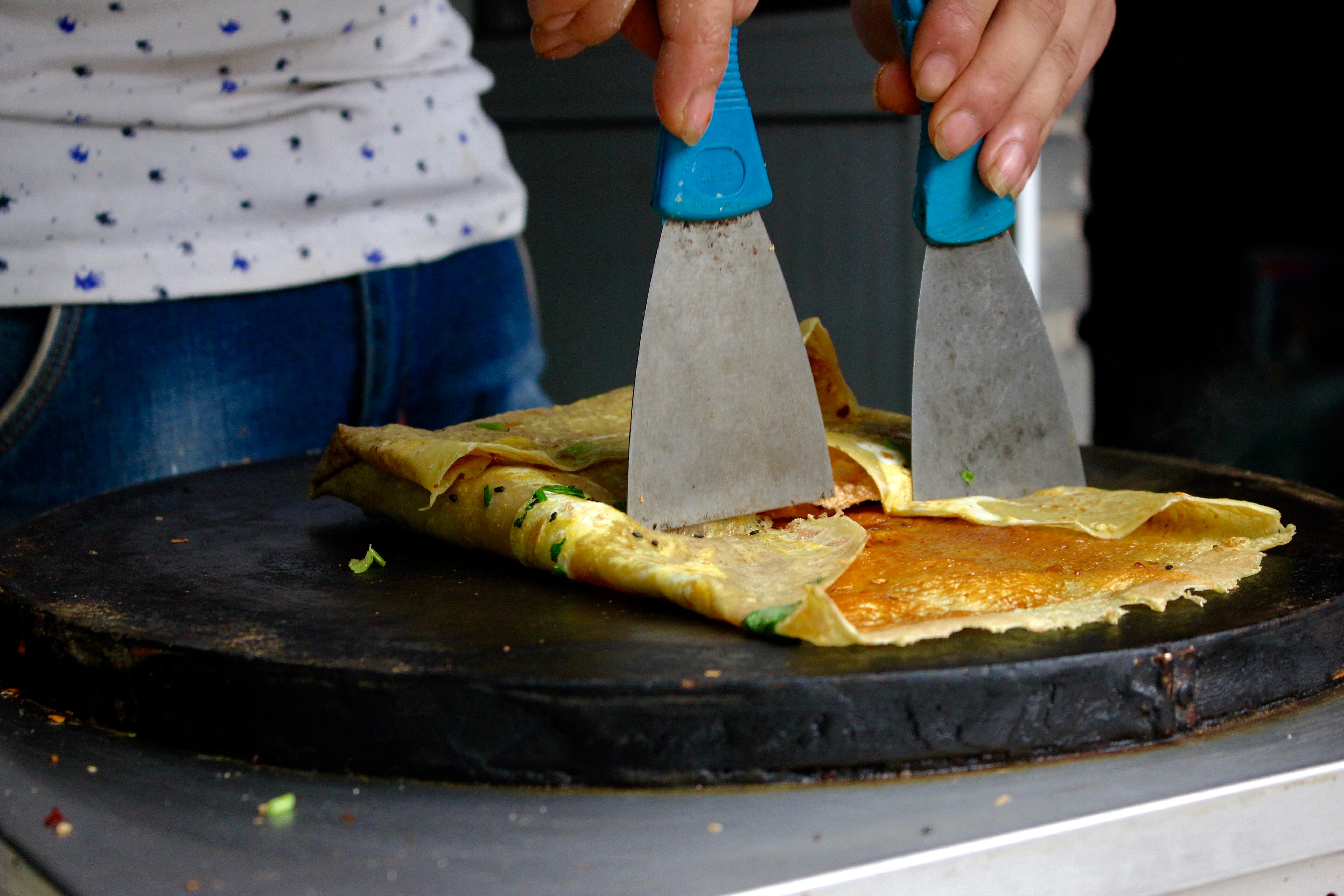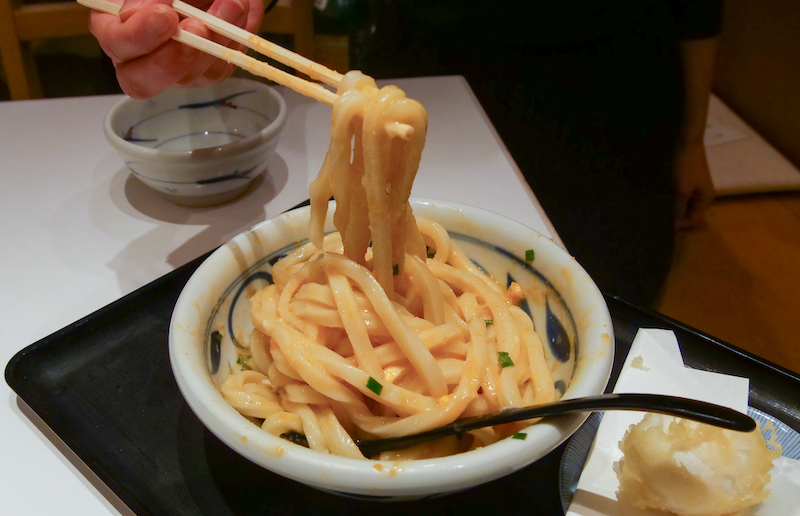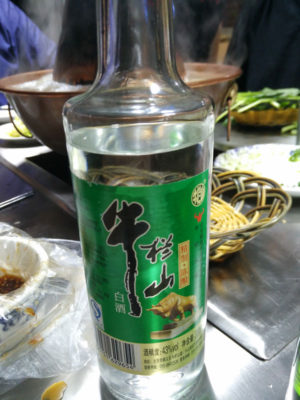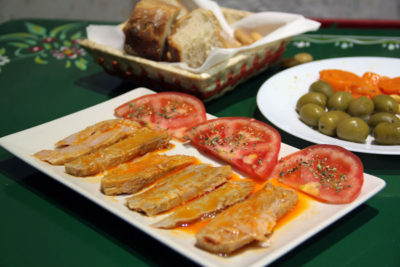We can't find the internet
Attempting to reconnect
Something went wrong!
Hang in there while we get back on track
Search results for
Rio
Hocus Pocus DNA: Magic Brew
In Rio, only specialty beer bars usually have a touch of sophistication, and generally, the beer there is much more expensive (mainly because of the high tariff on imported hops), the regulars are more demanding and the food is made by a “chef.” This in contrast to the humble botequim, the traditional family-run bars that serve simple snacks. But Hocus Pocus DNA strikes a balance between the two: it’s a brand-new bar with a botequim soul that slings craft beers and thoughtfully conceived appetizers to go with them. It’s also the name of an acclaimed artisanal brewery – one of the best local breweries in town, in fact, operating in Rio since 2014 – whose products are sold only in specialty stores and bars.
Read moreMexico City
CB on the Road: San Miguel de Allende's Mercados and Marchantes
To call San Miguel de Allende mind-blowingly picturesque is no hyperbole. Cobblestone streets and colonial facades enchant and inspire romantic notions from even the greatest cynic. Called by some “Mexico’s Disneyland for adults,” it’s a coveted destination for lavish fairytale weddings and romantic getaways and for expats and snowbirds to pass the time under azure skies in its dry, temperate climate. The historic center is peppered with fine-dining restaurants, stylish eateries, hipster pop-ups and cafés with picture-perfect open-air terraces. Its weekly farmers’ market rivals those of the “foodiest” towns in the US. So what about the “real” San Miguel?
Read moreTokyo
Holiday Gifts in Tokyo: Give, Receive, Repeat
In Japan, there’s a different version of Newton’s third law of motion that applies to etiquette: for every act of kindness, there must be a similar and equal act, usually in the form of a gift. Japanese people are perpetually cognizant of the opportunities and appropriate moments for giving gifts and the many meanings and rituals attached to them. Rather than considering it a burden, many of them love to give gifts and believe it a tradition worth observing. The gold standard for gift giving in Japan are the mid-year ochugen and the end-of-year oseibo, or seasonal presents.
Read moreBarcelona
Holiday Gifts: Barcelona's Baskets of Delectables
Barcelona’s food shops and colmados offer culinary treasures all year long, but the holidays are a particularly exciting time for browsing their wares. The festive window displays show magnificent gift baskets overflowing with tasty treats – with many Spanish and Catalan specialties among them. Perhaps the most desirable items in holiday gift baskets here are the seasonal sweets, which previous generations would amass in quantities that would serve as “emergency” treats for unexpected guests the rest of the new year. (Thankfully, one can now find these year-round, so there’s no need to hoard them.) We’ve written previously about artisanal turrón, which continues to be handmade by a few family-run companies.
Read moreAthens
Holiday Gifts in Athens: Edible Symbols of the Season
Holiday traditions in Greece, like so much in that country, are rooted in ancient Greek and Roman customs – pagan, of course – that evolved through Byzantine times and were adapted with the advent of Christianity. More recently, the westernization of Christmas and New Year celebrations has made those holidays here look more like the globalized version of them, for better or for worse. Greeks like preserving their old traditions, however, and some customs still persist, even if many Greeks don’t know where they came from. The Christmas season, known in Greece as Dodekaimero (twelve days), officially begins on December 24, includes the celebration for the New Year and ends on January 6 with the huge celebration of Theophania (the baptism of Jesus Christ by John the Baptist).
Read moreTbilisi
Season's Eating: Holidaze in Tbilisi
The godzilla-sized tree of lights is up on Freedom Square and a gazillion more streamers of lights twinkle for eight kilometers down Tbilisi’s main drag, a clear, impressive indication the holiday season is upon us once again. The best thing about celebrating Christmas here is that tradition does not require us to buy a bunch of stuff for people that they don’t need. In Georgia, the real meaning of Christmas is indulgence in the gastronomic sense. Birthdays notwithstanding, the first feast of the season is on December 17, Saint Barbara’s Day. Being an Orthodox Christian country, the December 25 is only celebrated by expats and those Georgians looking for an excuse to feast.
Read moreLisbon
Holiday Gifts in Lisbon: A Carioca's Coffee
Though ceramic dishes or tinned sardines are the standard take-home souvenirs for visitors to Lisbon, a less traditional – but still unique – gift from the city is the source of the warming aroma that permeates its cafés morning, noon and night. A strong bica (espresso) is an integral part of Lisbon’s smellscape, and the few chimneystacks in sight over peripheral skylines reveal that there are still local businesses providing beans to restaurants and traditional stores here. Consuming this product, which has a long history, is deeply embedded in the city’s day-to-day, but cultural shifts (today it is quaffed more at the bar rather than at home), means many of the old coffee shops are now obsolete.
Read moreLisbon
Cape Verdean Grog and Grub in Lisbon
Senhor Domingo serves up a wicked homemade Cape Verde “grog” from his simple restaurant in central Lisbon. The toast goes to him, for cranking up the morna, stirring up the cachupa and making this corner of the city a bit more Cape Verdean. We’re all better for it.
Read moreRio
Best Bites 2016: Rio
Our best eating experiences of the year include dishes at botequins old and new, as well as unexpected finds elsewhere in the city. Ajota Bar’s rooster One of the most delicious discoveries I made in Rio this year was the rooster from Ajota Bar, a very humble botequim – or traditional family-run bar – in Vila Isabel, a working-class neighborhood in Rio's North Zone. Chickens and galetos (three-month-old chickens) are very common in botequins, but not roosters, as they’re hard to cook well. Only a few bars have the guts to serve it, and of those, Ajota’s is the best. The owner and chef, Mr. Francisco, buys the rooster on Friday and brines it with spices overnight.
Read moreBarcelona
Best Bites 2016: Barcelona
Barcelona continued to thrill this year with its seemingly never-ending possibilities for great eating, from ambitious family-run eateries to neighborhood restaurants steeped in Catalan traditions to world-renowned temples of gastronomy. Granja Elena With its great gastronomic aspirations and a solid foundation in farm-to-table cooking and traditional Catalan recipes, this small Zona Franca granja (literally “farm”), which was been passed down through three generations, has gone from a simple shop serving breakfast and snacks to a full-blown restaurant and total culinary wonder. Run by the Sierra-Calvo family since 1974, Granja Elena is now helmed by the third generation, who are all industry professionals: Borja runs the kitchen, Patricia the wines and Guillermo the dining room.
Read moreMexico City
Best Bites 2016: Mexico City
Mexico is gifted with both a tantalizing array of local delicacies and street stalls beyond count, serving them up for prices designed to feed the masses. It’s paradise for adventurous foodies where the next great meal can be found by simply following one’s nose. Nevertheless, some spots rise to the top, usually building on tradition and a passion for the food itself. Arroces Baby Face In Mexico City, every year brings new discoveries, and I was fortunate in 2016 to discover a gem, parked just out of the way from major tourist footpaths … but only just.
Read moreIstanbul
Best Bites 2016: Istanbul
One of our most exciting discoveries this year was Yılmaz Tandır Evi in Istanbul's Feriköy neighborhood, where many people from the eastern Anatolian province of Erzincan have settled over the years. Yılmaz İngeç, a native of Erzincan's İliç district, serves only the finest ingredients from his hometown, including fresh honey, kavurma and tulum peynir, a salty, crumbly cheese aged in goatskin. A simple serving of fried eggs topped with tulum was a match made in heaven, perhaps our favorite breakfast this year. We were thrilled to stumble upon a secluded slice of the Black Sea province of Trabzon right here on the Asian side of Istanbul earlier this fall.
Read moreLisbon
Best Bites 2016: Lisbon
Lisbon is still one of the best cities in Europe for fresh, unpretentious seafood dining, despite the onslaught of fads and newfound taste for speculative real estate. Eating mollusks here – as at a cervejaria-marisqueira, a sort of old-school beer and seafood house – is not at all associated with the luxury it symbolizes elsewhere. Here, it is normal to dig out the insides of unique, claw-like barnacles or suck the heads of the freshest prawns for a decent price in a genuine atmosphere. And in such restaurants, forget the lime tart or crème brûlée afterwards: the purist’s dessert after a shell-laden chowdown is a prego – a garlic-laced beef sandwich that couldn’t be fancy even if it tried.
Read moreShanghai
Best Bites 2016: Shanghai
Shanghai's dining scene was abuzz with controversy this fall as the Michelin Guide landed in the city for the first time ever. You can't please everyone, but no one seemed happy with the disproportionate number of Cantonese restaurants that were recognized. Thankfully, there's still plenty of delicious variety in the city, starred or not, and we continued to chow down across the price and regional spectrum. A Da Congyoubing After 34 years of making the cult favorite scallion oil pancake, Mr. Wu was shut down by the government in September for not having the proper licenses. Thanks to the serious outcry from the city’s foodies, the district government helped him expedite his licensing, and delivery start-up Ele.me found a new spot just a couple blocks from his apartment.
Read moreTbilisi
Best Bites 2016: Tbilisi
Few things in life are more rewarding than eating in Georgia. However, a single night at a Georgian restaurant can also be a terribly mortifying experience. Georgians like to order big but the palate can only take so much. All the worse for guests, as they are routinely tortured into learning just how magnificent Georgian cuisine is in one sitting. This is the kind of gluttony meant to send you to hell, and it totally short-circuits your senses. You cannot contemplate the simple flavors in a piece of tender veal stewed in a tomato and pepper sauce when the table is covered with plates upon plates of pkhali, khachapuri, mtsvadi and so on while being obliged to raise one more glass of wine to wash down yet another toast.
Read moreAthens
Best Bites 2016: Athens (and Beyond)
With shops closing, pensions and salaries shrinking, and more and more Greeks feeling the pinch, it never ceases to amaze us that good food in the capital and elsewhere is still appreciated and faithful customers still abound. The restaurants below are just a few among the many wonderful, lively places that are managing to keep their standards despite enormous financial pressures. Their prices are affordable, their quality outstanding. Sea Satin Nino, Korthi Bay, Andros This is one of those restaurants that a Michelin Guide would rate not merely as “worth the trip” but “worth the detour.” Although it may take an hour’s drive from the port and half an hour from Hora, any meal at Sea Satin Nino is cause for celebration.
Read moreTokyo
Best Bites 2016: Tokyo
This was a year of culinary highs for sure, ranging from the ridiculous to the seriously sublime. McDonald’s Choco-Pumpkin fries Yes, you’ve read correctly. While out researching some serious Halloween treats I stumbled on a Mickey D’s seasonal specialty for Japan – Choco-Pumpkin fries. Not only did a picture of it on the menu look pretty awful, the thought of neither salt nor ketchup on my spuds seemed so wrong. And yet it turned out to be a truly impressive surprise. The standard fries at McDonald’s – or, as it’s known in Japan, makudonarudo – came with a packet of chocolate syrup and a packet of pumpkin syrup that you swirl over them yourself.
Read moreBarcelona
Gelida: Old Faithful
At the beginning, Gelida was just a bodega where Joan Llopart i Figueres, who came from the village of Gelida in Penedés, offered Catalan wine, cold cuts and a few traditional Catalan dishes cooked by his grandmother, like butifarra amb mongetas (boiled sausage with beans). Llopart i Figueres and his wife worked here until they were in their 80s. They were succeeded by their two children, Teresa and Alberto, who have always been involved in the family business and who continue to run the place today alongside their respective spouses, Josep and Luci. Alberto and Luci’s son, Gerard, helps to manage the restaurant, and Laura and Santi, family friends who live nearby, joined the team in recent years as dining room manager and chef.
Read moreRio
Bar Ocidental: Little Fish, Big City
Downtown Rio, full of historical monuments, colonial architecture and daytime bustle, grows emptier during the evenings. But for the last half century, one cobblestone street has given commuters a reason to stick around: sardines. Salty, crispy, scrumptious fried sardines. Sitting at the foot of the Matriz de Santa Rita church, Beco das Sardinhas (Sardine Alley) is a cluster of five bars that pour into Rua Miguel Couto, a pedestrian-only street dedicated to the little fish, and is both a favorite after-work destination and jumping-off point to downtown Rio’s nightlife. On a recent Friday evening, customers – some in suits, some in shorts and flip-flops and others dressed for a night out on the town – sat at the plastic tables that fill the alley.
Read moreAthens
Building Blocks: Avgolemono, Greece's Sauce for All Seasons
Is there a flavor more typically Greek than avgolemono, the smooth yet tart sauce that enriches dishes on virtually every restaurant menu in this country (apart from the souvlaki joint)? You’ll find it livening up soups of every description, poured over dolmades (wraps) of cabbage, vine leaves or chard and stuffed zucchini, thickening dozens of fish, meat, poultry and vegetable stews and fricassees. It marries particularly well with artichokes, in a famous delicate dish called anginares ala polita (or Constantinople-style), and binds the interesting innards in mageiritsa, the traditional fast-breaking stew-like soup eaten on Easter eve.
Read moreTbilisi
Gabriadze Café: Classic Revival
When we arrived in Tbilisi in 2001, there was one café/restaurant that was a beacon to those seeking an alternative to the traditional Georgian dining experience of stark rooms and banquet tables or greasy spoons with clunky tables and little stools. It was a funky little crooked house of pure originality that served the regular dishes, but with a personal homey touch that suited the place perfectly. Although it felt like a world apart, the art installation cafe was Georgian to the bone, being the creation of Rezo Gabriadze, the renowned artist, writer, sculptor and film and stage director.
Read moreLisbon
Estrela da Bica: Local Star
Despite being home to Lisbon’s most photographed street, Bica has maintained its close-knit-community feel, with encroaching internationalization still held at arm’s length from these bumpy cobbled lanes and steep stairways. The small residences here have generally been passed down through generations, meaning a steadfast family vibe where everyone’s laundry is, literally, there for all to see. Estrela da Bica is a cozy, rustic restaurant at the bottom of this tiny hill district that perhaps marked the first sign of middle-class interest here. Historically inhabited by fishing families, Bica is becoming increasingly touristy by day and, thanks to the several bars around, more of a hangout at night.
Read moreShanghai
Holy Cow: Beefed-Up Hotpot
We’d just about given up on hotpot, what with last year’s scandals of rat meat parading as lamb and opiates mingling with the Sichuan peppercorn to give diners a real buzz. But 2014 has seen the trend of farm-to-table dining hit Shanghai in a big way, spurred on by these food safety concerns. The most recent entrant to the organic dining scene is the aptly named Holy Cow. More than just a phrase made famous by Chicago Cubs announcer Harry Caray, Holy Cow is a healthy hotpot restaurant specializing in – you guessed it – beef, plus vegetables sourced from owner Anthony Zhao’s family farm. Loyal CB eaters might remember Zhao from his Shanghainese lunch hotspot Mi Xiang Yuan.
Read moreBarcelona
Vell Poblenou: The Rice Stuff
When people think of rice and Spain, they think of paella. In Barcelona there are hundreds of places to eat paella. And every Thursday you can find it on the menú del día at most restaurants across the city. There’s more to Spanish rice dishes than just paella, though. The word “paella” didn’t even appear until the 18th century; recipe books from the Middle Ages talk only of rice, and particularly the Valencian and Catalan kinds. In fact, “paella” originally referred to the pan used to cook the grain, but eventually came to describe the dish as we know it: rice prepared so that the water or broth completely evaporates and sometimes is left with a toasted layer on the bottom. But enough about paella!
Read moreMexico City
Restaurante Lety: Fungus on the Mountain
For the most part, Mexico City pampers its citizens with year-round warm, sunny weather, give or take the occasional downpour in the rainy season. And like any spoiled child, chilangos have grown so accustomed to living in such a temperate clime that any slight deviation registers as almost unbearable. At 19 degrees C, pedestrians cloak themselves in winter coats and hurry down the sidewalk, worrying that they will freeze to death on the two-block walk from their parked car to their front door. It’s rumored that chilangos are so unused to seeing their own breath in the cold that they mistake it for their souls escaping their bodies, augmenting their hatred of frigid weather.
Read moreIstanbul
Hadramot Yemen: Beyond Falafel
Istanbul's conservative Fatih district has perhaps the highest concentration of Syrian refugees in the city, and the tree-lined Akşemsettin Street boasts a staggering number of Syrian eateries, from spacious sit-down affairs with full menus to hole-in-the-wall, standing-room-only kiosks slinging shawarma, fried chicken, and falafel. Having popped up rapidly amid the waves of Syrians fleeing the devastating civil war that has displaced more than half the country's population, these establishments have made a firm imprint on the culinary scene. While the falafel at many of these places is a mediocre afterthought overshadowed by the more popular poultry-based items, we found one counter offering falafel and falafel only, serving up a generously crafted sandwich the size of a chubby child's forearm for a measly TL 2.50 (US$0.75).
Read moreLisbon
Tasca Tables: Office Workers' Refuge at O Cartaxinho
Avenida da Liberdade is commonly acknowledged to be the most luxurious and expensive artery in Lisbon. It’s the obvious place to go to buy a famous designer’s dress or fancy jewelry. It might be surprising to learn, then, that it’s also the place to go for good pernil assado (roasted pork shank) or cabidela (chicken blood rice). The reason is simple: the area is filled with great tascas, which draw a wide range of local office workers, including lawyers, business consultants, public servants and unpaid interns. Among these tascas, O Cartaxinho is one of the best, if not the best. Unsurprisingly, it’s also one of the most popular – it’s not unusual to see groups waiting outside for a table during lunchtime.
Read moreTokyo
Udon Shin: Rolled to Order
Anticipating a line, we arrived ahead of our appetite, but the slightly acrid smell of fresh dashi wafting over the street hurried our hunger. Tucked behind a handful of confounding corners southwest of Shinjuku Station in a mixed-use neighborhood of apartments, shops and offices, Udon Shin has consistently ranked among the best udon restaurants in Tokyo since opening in April 2011. At around ¥1000 (US$9) per meal, you feel like you're getting away with something. Owner and chef Shinji Narahara deftly handles the classic accompaniment to udon (think homemade dashi, deep-fried tofu and tempura) but elevates the humble noodle to modern heights with their trademark carbonara udon.
Read moreIstanbul
Meyhane Moments: Fall in Istanbul with Rakı and Meze
Fall is in full effect in Istanbul and its our favorite time of year (not that there is a bad time) to hunker down in a meyhane around some rakı and meze. Our meyhane walk stops at three of our favorites and involves the sampling of no small amount of both.
Read moreElsewhere
Baijiu in Beijing: White Lightning in the Capital
Baijiu, which translates literally as “white alcohol,” is a clear spirit made predominately from sorghum, although glutinous rice, maize or other grains can also be utilized in various proportions. It is ubiquitous in China at official events, like weddings, business deals, and boozy government lunches, but under President’s Xi Jinping’s ongoing crackdown on government largesse, sales are down about 13 percent from a peak in 2012. As baijiu growth falters, many brands are looking abroad to push sales – not only to introduce it to foreigners, but also to keep it relevant to the younger, wealthier generation of Chinese who are living as expatriates.
Read moreAthens
Oinomagereion to Trifylli: Fan Favorite
Hidden behind the imposing stadium of the Panathinaikos football team – the green team as opposed to its eternal rival, Olympiakos, the red team – lies a tiny eatery that recalls Athens before the 1960s, when urban sprawl destroyed everything. Occupying two adjacent whitewashed houses, Oinomagereion to Trifylli, named after the team’s clover logo, has been serving simple, delicious food to loyal customers for the last 60 years. The taverna was founded in 1962 by Kyria (Mrs.) Koula, the present owner’s mother, in order to earn additional income for her family.
Read moreLisbon
Damas: Funky Kitchen
At the end of Rua da Voz do Operário, the main road that leads up to the hilltop of the previously sleepy Graça neighborhood, is a new, hip Lisbon kitchen that is reflecting the city’s growing hunger for great food and a good time. Damas, as the name indicates, is run by two women who have both previously worked in some of the city’s well-known food institutions, including Chapito. The restaurant, bar and club has been popular pretty much since it launched in 2015, thanks to its combination of knowledgeable chefs, classic and not-so-classic dishes done well, and a regular music program that ranges from punk to afro-beats.
Read moreBarcelona
El Cocinero de Damasco: From Syria, with Shawarma
“I don’t want to be famous, I just want to do my best and make good food. You have to work with honesty, from the heart,” Salem Kabbaz tells us. Born in Damascus in 1945, Kabbaz is smiling and animated as he chats with friends and suppliers and walks in and out of his restaurant in the Barrio Gótico. A very small, discreet sign above the door marks his eatery, El Cocinero de Damasco – the Damascus Cook – which is devoted to Syrian specialties like shawarma, hummus and falafel. Neighboring residents and City Hall workers come for take away or to eat at the few tables inside the small eatery.
Read moreRio
Ajota Bar: Old Bird
Rio’s bar culture is crazy for chicken. It’s common to see at bars dozens of the cooked birds laying within heated glass cases, awaiting hungry customers. The more popular the botequim, the more parts of the chicken are available. In the fancy bars of Ipanema and Leblon you can only find voluptuous breasts and legs, accompanied by salads and risottos. But in more humble botequins in the North Zone or further out in the suburbs, you’ll find gizzards, feet, beaks, and even rear ends. Yes, cu de galinha is a rare delicacy in Rio... Not only is every part of the chicken appreciated, but also all ages of the bird.
Read moreElsewhere
Apomero: Eyes on the Pies
On our first morning in Nicosia we sat down at a sunlit outdoor table in a picturesque cafe and asked the waiter what Cypriots ate for breakfast. “Pies,” he said, and brought us a selection of savory ones stuffed with olives, cheese and spinach. They came straight from the microwave – grayish-beige, overheated and sodden – and tasted like greasy cardboard. It wasn’t until we discovered Apomero that we realized it didn’t have to be that way. Hidden down a shaded side street in the gentrifying part of the old town, this tiny cafe and pie shop with its small indoor space and jumble of tables and potted plants outside has a much more relaxed feel than its stuffier neighbors.
Read moreIstanbul
Basta Street Food Bar: Gourmet to the People
Dürüm is the specialty at Basta Street Food Bar, but you won’t find a smoky grill inside this tiny Kadıköy storefront. With its bright turquoise counter, tile-patterned floor, and steel-topped, light-wood stools, Basta looks more like a hip café than a traditional kebab joint. “One customer came in, sat at the counter, took one look at what we were doing in the kitchen and walked right out,” laughs Kaan Sakarya. The former chef of the highly rated Nicole restaurant in Istanbul, Sakarya opened Basta in April along with colleague Derin Arıbaş. Their aim: applying their fine-dining training to gourmet fast food – specifically dürüm, grilled meat wrapped up inside lavaş flatbread.
Read moreMexico City
La Esquina del Chilaquil: Hangover Helper
On a Sunday morning in Mexico City’s Condesa neighborhood, the few people on the street mostly jog or bike or power walk. Trainers adorn their feet, spandex hugs their thighs, dogs tug their leashes. These paragons of fitness select exercise to combat their hangovers, a choice that reflects the aspirational character of the upper-middle-class neighborhood. Many of the restaurants and cafes in the neighborhood encourage these health-centric lifestyles, as “natural this” and “green that” and “vegan blah blah blah” stores appear on every block. But like a chocolate chip cookie infiltrating a salad, the puesto on the corner of Alfonso Reyes and Tamaulipas stands in open defiance of the neighborhood’s pursuit of physical wellness, opting instead to pursue hedonistic aims.
Read moreElsewhere
La Caleta: Cádiz in Madrid
Though it has always taken a backseat to Barcelona in foodie terms, Madrid, the sprawling Spanish capital, has upped the ante with its increasingly varied gastronomy and adaptation of new food concepts. As a centralized city, the cultures of separate Spanish regions – still a political talking point – is reflected here in a gastronomical microcosm: Galician eateries, Basque pintxos, Asturian snacks, etc. This, together with the ir de tapas in different neighborhoods, new avant-garde chefs, traditional taverns and a few imported hipster inventions, creates an interesting mosaic among the city’s already high density of restaurants and bars. Lavapiés is Madrid’s best-known neighborhood for cultural plurality, and that includes its food offerings.
Read more


















































